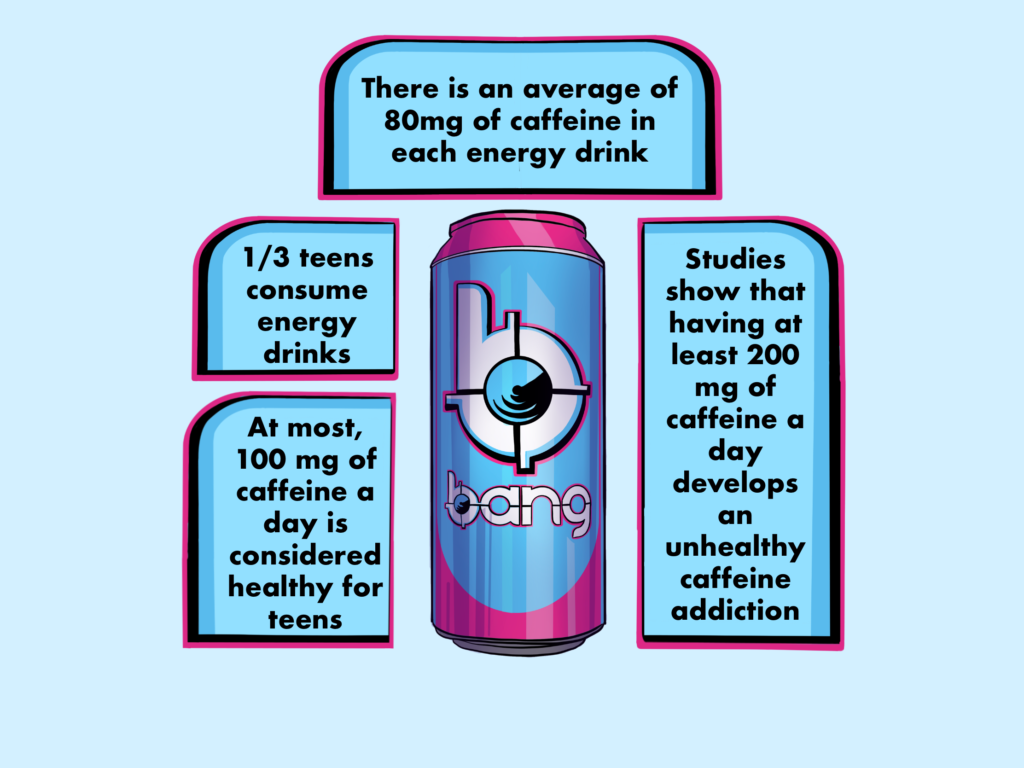Teens ignore negative effects of caffeine consumption

Divy Bose | The Chronicle
Every sip counts.
Students at Mason High School (MHS) can be found with an energy drink in their hands from class to class, prying to keep their eyes open. As students continue to thrive off of these drinks, the popularity of energy drinks has skyrocketed in past years.
Many students, however, are unaware of the health consequences that come with drinking can after can, as the milligrams of caffeine pile up within their bodies. With the possibility of developing a strong dependency on caffeine, students become wired to have a certain amount of caffeine; thus becoming addicted.
Teenagers have developed addictions that can cause health issues and concerns later down the line. Nutritionist Dawn Weatherwax, who specializes in sports nutrition and health at Sports Nutrition 2 Go, said that teenagers will go to desperate measures to keep their eyes open and simply feel better, but that they will later regret it.
“Caffeine is simply a drug,” Weatherwax said. “Once you start, it is difficult to get off of it. [But] it is possible and that is what teenagers do not want to hear.”
Students have made drinking an energy drink throughout the day a routine to keep them “alive” to stimulate endurance. Well-known for his energy intake, Junior Will Murphy said that his busier days require at least one energy drink per day.
“Energy drinks demand my focus,” Murphy said. “I cannot always fit in a good six to eight hours of sleep so I rely on the drink to give me the efficiency I need to get either a good workout in or homework done.”
This “get it done” mentality with many students is what propels the caffeine intake as a response to stressful amounts of homework or tasks. Murphy said that each drink actually benefits his productivity by giving him the motivation to finish two things at once in his more advanced classes.
“If I have two essays due on the same day, I can crank both of them out at the same time after a drink,” Murphy said. “Without each drink though, I feel unaccomplished.”
The appeal of energy drinks is what students tend to be drawn toward as well, such as the color or name brand. Junior Grace Major said that hearing about what new flavors there are and hearing about the names of the drinks gets her to buy them quite often.
“I go for what I think sounds good and looks good,” Major said. “I always get excited to try new flavors and tell my friends about them. They give me the energy I think I need in the morning. I love the appeal of energy drinks, specifically the popular Alani New brand.”
With new drinks on the rise, the energy boost’s rejuvenation has the same effect as a cup of coffee considering their similar amounts of caffeine. Weatherwax said that teenagers tend to fall into the trap of overriding safety precautions in order to stay on task.
“Students don’t eat right or get enough sleep when it comes down to it,” Weatherwax said. “Kids are drinking these sugary and caffeine-loaded drinks when it really is not for them to have.”
Since caffeine is known to keep the energy up, student-athletes view caffeine as an opportunity to store energy for practices or games after school. Weatherwax said that as a sports nutritionist, athletes should turn away from them.
“Energy drinks are not to be used for athletic performance or any competition,” Weatherwax said. “These drinks instead cause insomnia, shortness of breath, or rapid heartbeat that can lead to eventual heart issues or worsen current complications.”
Energy drinks continue to not scare students away though as some claim to know where they stand with their limit. Murphy said that knowing his own personal dependency level has benefited him.
“There’s a spot between a good, beneficial, and an unhealthy amount [of caffeine],” Murphy said. “I have never crossed my own limit which has kept me in check, but every student’s caffeine intake is different no matter the drink.”
Students who make caffeine a part of their daily routines experience withdrawal when they go without it, creating massive headaches and making it even harder to concentrate. Major said that without her caffeine fix in the day, problems will arise.
“I tend to get really bad migraines or headaches without at least drinking one a day in order for myself to just feel good,” Major said. “If I forget to pack it with me for even one day to school and I have a test, I will most likely struggle.”
Learning to adjust to that one-hundred milligrams per day that are considered healthy for teenagers is a challenge that is hard to overcome. Weatherwax said that drawing back from the extreme amount that they’re already accustomed to is what will make a safe consumption possible.
“Try to find the reason why the addiction has developed and slowly go backward,” Weatherwax said. “Set those goals that are necessary to slowly get back off of the reliance that had developed on the extreme number of caffeine.”
Certain labels on energy drinks are evident such as “eighteen years or older” or “do not consume if any heart issues”, but students continue to drink anyways, ignoring health risks. Weatherwax said that students who do not take the initiative of taking these precautions before thinking about taking another sip are at fault.
“Every drink most likely has an age limit or restriction on it,” Weatherwax said. “I am not saying that this has stopped every teenager, but in reality, it should.”
Graphic by Allison Droege
